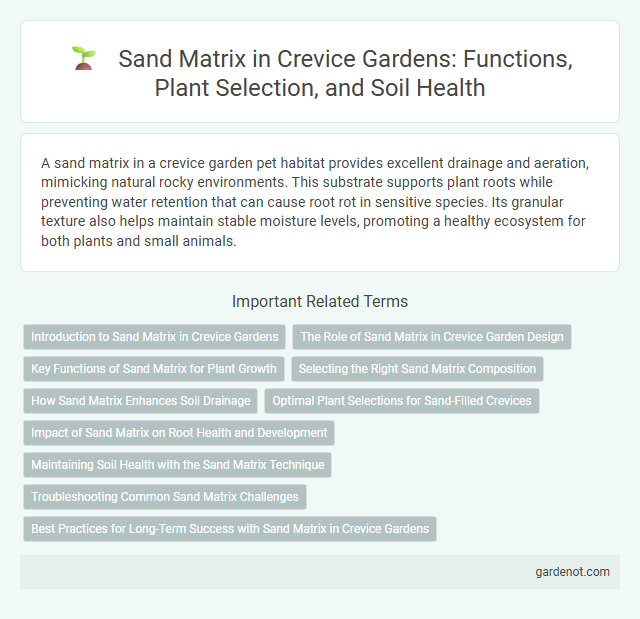A sand matrix in a crevice garden pet habitat provides excellent drainage and aeration, mimicking natural rocky environments. This substrate supports plant roots while preventing water retention that can cause root rot in sensitive species. Its granular texture also helps maintain stable moisture levels, promoting a healthy ecosystem for both plants and small animals.
Introduction to Sand Matrix in Crevice Gardens
Sand matrix in crevice gardens provides excellent drainage essential for the survival of alpine plants adapted to rocky environments. Its coarse texture prevents waterlogging while maintaining adequate moisture retention, mimicking natural mountainous conditions. Properly graded sand mixed with small gravel enhances root aeration, promoting healthy plant growth in narrow, vertical crevices.
The Role of Sand Matrix in Crevice Garden Design
The sand matrix in crevice garden design plays a critical role in promoting excellent drainage and aeration, essential for the health of alpine and drought-tolerant plants. Its coarse texture prevents waterlogging by allowing rapid water infiltration, mimicking natural rocky crevices. This substrate also stabilizes plant roots while facilitating nutrient retention, ensuring optimal growth conditions in constrained spaces.
Key Functions of Sand Matrix for Plant Growth
The sand matrix in a crevice garden provides essential aeration and drainage, preventing waterlogging while retaining adequate moisture for plant roots. Its granular structure facilitates oxygen flow and root penetration, supporting healthy growth of drought-tolerant and alpine plants. The sand also aids in nutrient retention and gradual release, optimizing the availability of minerals critical for plant development.
Selecting the Right Sand Matrix Composition
Selecting the right sand matrix composition for a crevice garden is crucial to ensure proper drainage and root aeration. A mixture with 70-80% coarse sand combined with organic matter such as compost or peat moss creates an ideal balance for water retention and nutrient availability. Using sharp, angular sand particles over fine or rounded grains helps prevent compaction, promoting healthier plant growth in crevice garden environments.
How Sand Matrix Enhances Soil Drainage
Sand matrix enhances soil drainage by increasing pore space, which allows water to flow more freely through the soil profile. The granular texture of sand prevents compaction and reduces water retention, promoting rapid infiltration and aeration around plant roots. Improved drainage in crevice gardens minimizes waterlogging, ensuring optimal root health and nutrient uptake.
Optimal Plant Selections for Sand-Filled Crevices
Succulent species such as Sedum, Sempervivum, and Delosperma thrive in sand-filled crevices due to their drought tolerance and shallow root systems. Alpine plants like Saxifraga and Arenaria also perform well, benefiting from excellent drainage and minimal soil retention in sand matrices. These plants optimize growth by exploiting the well-aerated, nutrient-poor conditions typical of sand-filled crevice gardens.
Impact of Sand Matrix on Root Health and Development
A well-structured sand matrix in crevice gardens promotes optimal root aeration and drainage, essential for healthy root development. By preventing waterlogging and enhancing oxygen availability, the sand matrix reduces root rot and supports robust nutrient uptake. This environment encourages deeper root penetration, leading to increased plant stability and growth vigor.
Maintaining Soil Health with the Sand Matrix Technique
Maintaining soil health with the sand matrix technique involves enhancing drainage and aeration, crucial for crevice gardens that mimic rocky habitats. This method promotes microbial activity and root growth by preventing waterlogging and nutrient depletion in the substrate. Regular incorporation of organic matter alongside the sand matrix ensures balanced nutrient cycling and sustained soil vitality.
Troubleshooting Common Sand Matrix Challenges
Sand matrix in crevice gardens often faces drainage issues, leading to water retention that can suffocate plant roots and promote fungal growth. Ensuring proper grain size distribution and incorporating coarse sand layers improves aeration and prevents compaction. Regular monitoring and adjusting moisture levels help maintain an optimal balance, supporting healthy root development and plant vigor.
Best Practices for Long-Term Success with Sand Matrix in Crevice Gardens
Maintaining a well-drained sand matrix is essential for optimal root health and moisture regulation in crevice gardens. Using coarse, angular sand mixed with organic matter enhances aeration and nutrient retention, preventing compaction over time. Regular monitoring of sand texture and periodic replenishment ensure sustainable plant growth and longevity of the crevice garden ecosystem.
Sand matrix Infographic

 gardenot.com
gardenot.com